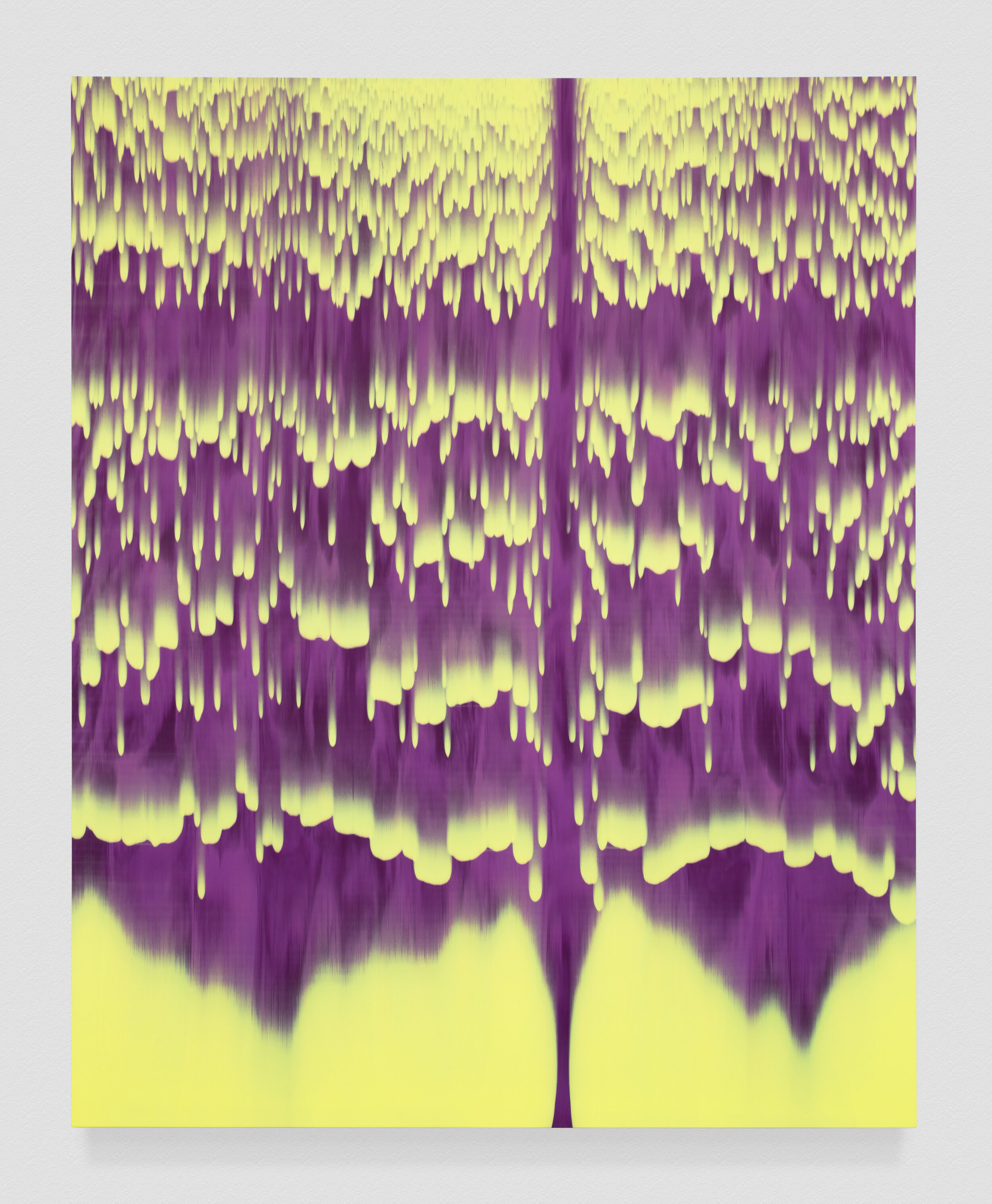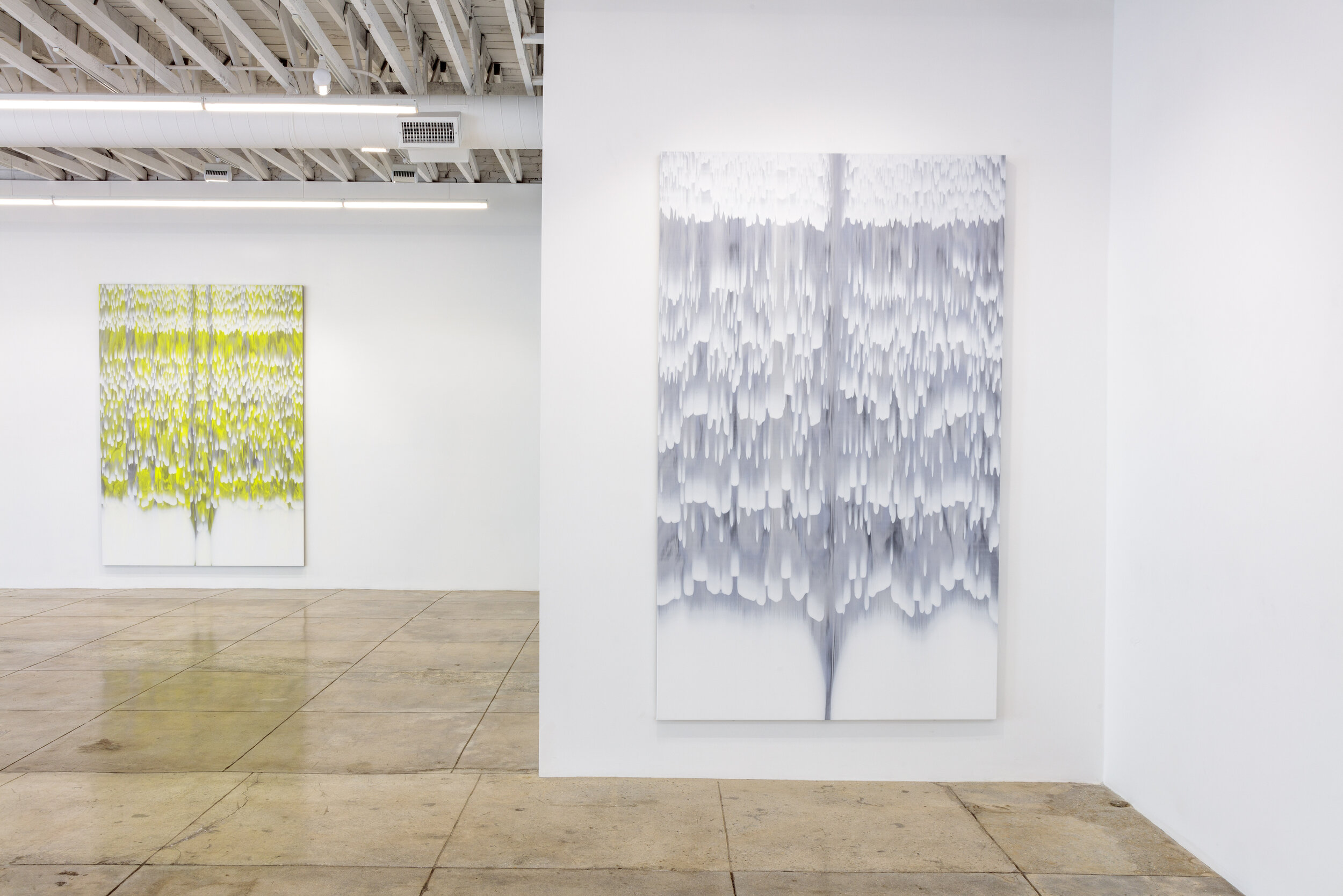
Stanley Casselman
A conversation with the painter on the occasion of 15 degrees of Entropy, his new exhibition at Lowell Ryan Projects.
Interview by Dan Golden
“I’m not interested in what we know, but by that which we don’t.”
— Stanley Casselman
Dan Golden: Congratulations on your new show at Lowell Ryan Projects. I really enjoyed engaging with this new work in person and would like to start the interview by hearing your thoughts on the meaning of the exhibition's title, 15 degrees of Entropy.
Stanley Casselman: Thanks for your kind words about the show. To say that one needs to see the work in person to get it is an understatement. The way in which light moves off of the screen simply doesn’t translate in photography.
15 degrees, as you read, is a technical nuance to the final pass in the process of making these paintings—more on this later. Entropy, however, speaks to the core of the philosophical side of my practice. The term speaks to the notion of disarray or random occurrence within a given system. Random occurrence, or as I like to think of it, ‘the physics of the moment’ is fundamental to life. Whether it’s a chance encounter that alters the course of one’s life or the asteroid that killed the dinosaurs, chance is an inherent part of our existence.
I make art by the simple notion; I’m not interested in what we know, but by that which we don’t. I’m also only compelled by what (to me) is visually stunning. Thus I want to make and see things that I’m surprised by, but again it has to excite me, and in some, at least small way needs to expand the language of what’s visually possible. Hence, I set up parameters whereby random things will occur. Looked at another way, my process is a means to getting consciousness out of the way.

Untitled (yellow and plum YP21G6) 2021, acrylic on polyester, 98 x 79 inches

Untitled (pink and green PG20E7), 2020, acrylic on polyester, 75 x 60 inches
Talk to me about the relationship between order and disorder in your work, both from a process perspective and philosophically.
The two are visually interlinked in the sense that one informs the other that it’s unique or interesting and vice versa. Think of the two as a contrast. You need the sweet to balance the salt, hence why caramel corn should be the same kind of class 3 felony as heroin. An entirely red wall of the most sumptuous shade quickly becomes boring as all hell unless there’s something to contrast it and inform us of its radiance.
From a process standpoint, the order in these paintings emerges from the disorder that occurs in the movement of the flat bar spreader. Disorder being the turbulence and wave action that occurs within the paint from it being moved across the screen, between the underside of the flat bar spreader and the screen itself. Best I can tell, what’s happening there is a combination of wave action, gravity, and surface tension. Long and short is that little bits of paint are falling to the screen, getting caught by it and dragged to make the marks that we see.
Take any of the paintings, and all of the marks that one sees ‘randomly’ came out of the mass or solid area(s) at the bottom. A simple but not exactly accurate analogy would be loading a brush with paint and moving it across a wall where it would create a solid mark that would turn into scumbling marks, and it eventually would run out of paint. These paintings are akin to that, but I’m using a large flat bar spreader (essentially a pallet knife and always a bit wider than the overall width of the piece) and moving paint across an open screen instead of a solid surface. The last point offers or creates a very different ballpark for physics to do what it does.
Serendipitous Illusion: Champagne, 2020, Acrylic on polyester, 86 x 80 inches
Serendipitous Illusion: Champagne (detail), 2020, Acrylic on polyester, 86 x 80 inches
There is something about this new series that resonates particularly strongly for me. I sense a new level of (elegant) restraint and stillness in motion in these paintings. Can you share a bit about how these works may be either inline or a break away from your previous work?
These paintings have their roots in 2010 to 2012 but were essentially put on hold when in 2012, Jerry Saltz walked into my studio, and I shifted gears to painting on canvas. Last May (2020), I decided to revisit the work, the process that goes along with it, and here we are.
That said, these new paintings are related to the older works but have a lot more gravity, air, and an organic sensibility to them. These paintings breathe in their own unique way and convey a story, unlike any paintings I’ve made previously. Not to repeat ‘organic,’ but getting a sense of distance from things that feel contrived is always in the back of my mind. Time will tell, but I’m pleased with what’s going on in these pieces.
Untitled (yellow and gray YG218B), 2021, acrylic on polyester, 108 x 78 inches
Untitled (yellow and gray YG218B) (detail), 2021, acrylic on polyester, 108 x 78 inches
Can you share a bit about your creative process with our readers?
There are several unique elements to the paintings that collectively turn into what you see. First is the screen that they are painted upon. It’s silkscreen fabric. Ironically it’s 100 percent polyester, but back in the day was made from silk, hence the name. The mesh I use has 110 threads in each direction per square inch, and the screen, I believe, is 36 percent open area. The other 64 percent is the physical make-up of the screen. These pieces are made wet on wet, start to finish. All of the paint being moved across the surface is done so by the tool I referenced previously, a flat bar spreader (aluminum blade with a long wooden handle). These paintings are made flat on the floor and each in three passes of the flat bar spreader. The first pass is to create the under-painting or background. I typically use three colors, poured together into a pale such that they mix, but not completely. I then pour that mass onto the leading edge or starting edge of the painting. I move that mass (for a large painting, it’s about two gallons) across the open screen and cover the entire surface. Wave action (between the underside of the flat bar spreader and the screen) is why one sees repetition in the background layer. The next layer is a thin layer of clear acrylic medium. This layer helps separate the just laid down under-painting from the marks layer that will happen above it. The final or the marks layer goes on. As I alluded to previously, all of the “marks” one sees emerge from the solid area resulting from the beginning of the final pull. And that final pull starts at about a 15-degree angle to the screen, hence the show's title.
Untitled (Orange and Blue OB20R2) (detail), 2020, acrylic on polyester, 73 x 60 inches
How did this exhibition at Lowell Ryan Projects develop?
I knew Mike and Virginia from New York when they had Mike Weiss Gallery. We met at Mana Contemporary in 2012. We loosely kept in touch over the years, but largely thanks to Instagram, we reconnected in 2020, and here we are.
If we entertain for a moment that the relationship between an artist and his/her gallery is similar to that of a novelist and their editor—how would you describe the collaborative process between you and Lowell Ryan Projects in regards to this new group of paintings?
Mike and Virginia are very bright and insightful people. We tossed around many variations of the show that you now see. Mostly in relation to the number of pieces and placement. Due to covid and the fact that I’d never set foot in the gallery, I had to trust their judgment about many of the particulars. Up until about two weeks before the show was due to open, I wasn’t vaccinated and didn’t know if I would go out to see it at all. Ultimately I threw caution to the wind and boarded a plane. Long and short, I couldn’t have been more pleased with how it was hung and lit, stunning!
Installation view, Stanley Casselman, 15 Degrees of Entropy, Lowell Ryan Projects, March 13—April 24, 2021
Installation view, Stanley Casselman, 15 Degrees of Entropy, Lowell Ryan Projects, March 13—April 24, 2021
Installation view, Stanley Casselman, 15 Degrees of Entropy, Lowell Ryan Projects, March 13—April 24, 2021
Thinking of artistic narratives and through-lines, I sense a connection between your work and artists such as Barnett Newman, Frank Stella, and Larry Poons. I’m curious to hear which artists may be of particular importance to you.
So many artists have been and will continue to be an influence on my work.
The shortlist of the giants amongst the greats would be Pat Steir, Anselm Kiefer, Rothko, Krasner, Pollock, Kline, Joan Mitchel, and Arshile Gorky. I could write a book about the influence of these folks upon my work, but long and short, I knew in every fiber of my body that I wanted to live my life painting when I first encountered Pollock’s One: Number 31 at MoMA in 1984. I shed tears at Pat Steir’s bewilderingly magnificent paintings at Cheim & Read in 2014. Just a couple of examples of how other artists have moved the needle within me.
You live and work on the East Coast, but are originally from California. Do you feel like location has any impact on your work?
I’m actually from Phoenix, but went to college in LA and lived there on and off for ten years. I’d like to think I’d be happy painting in my own private Idaho on Gilligan’s Island, but truth be told I need interaction with art and other artists. Pre-covid I’d of said that there’s no second to NYC. It’ll be back someday, but for the moment the art world here has taken it on the chin. So to answer your question, yes it does. However, regardless of location Instagram is an extraordinary tool to discover and see art, but ultimately for me, I need to experience it.
What are you working on now/next?
Working on a collaboration with another artist. I wish I could say more, but we agreed to keep it on the down-low until we’re ready to show it. Stay tuned…
Stanley Casselman
15 Degrees of Entropy
Lowell Ryan Projects
March 13—April 24, 2021
All images Courtesy of the Artist and Lowell Ryan Projects.








